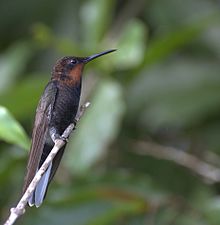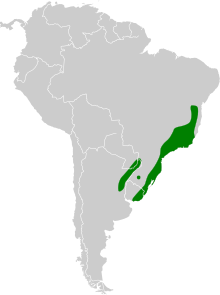Black hummingbird
| Black hummingbird | ||||||||||||
|---|---|---|---|---|---|---|---|---|---|---|---|---|

Black hummingbird |
||||||||||||
| Systematics | ||||||||||||
|
||||||||||||
| Scientific name | ||||||||||||
| Florisuga fusca | ||||||||||||
| ( Vieillot , 1817) |
The Black Hummingbird or sadness Hummingbird ( Florisuga fusca ) is a species of bird in the family of hummingbirds (Trochilidae). The species has a large distribution area in Brazil , Uruguay , Paraguay and Argentina . The IUCN assesses the population as Least Concern .
features
The male black hummingbird reaches a body length of about 12.8 cm, with the wings 8.5 cm, the tail 4.8 cm and the beak 2.1 cm long. It weighs approx. 9 g. The female black hummingbird reaches a body length of approximately 12.8 cm, with the wings 7.9 cm, the tail 4.1 cm and the beak 2.1 cm long. It weighs approx. 7 g. Most of its body, beak, and feet are black in both sexes. The wing coverts, the dorsal back and the central control feathers have a green color with a blue bronze sheen. The wings are blackish brown. The flanks are white. The lateral tail feathers are lined with white. Fledglings also have black bodies, bills and legs, but the sides of the throats are reddish brown. The feathers on the back of the head, the back of the head and the upper tail covers are lined with reddish brown. The tail is black and only the outer pairs of feathers with white areas. The flanks and the middle of the belly are white, the belly side feathers as well as the under tail coverts have white hems.
Way of life
At times the black hummingbird is very common. From January to April it often flies to the Asiatic kapok tree when searching for nectar , while from May to July it tends to fly towards eucalyptus flowers .
Breeding behavior
The nests are approx. 65 mm high. The outer radius is approx. 62 mm, the inner radius approx. 27 mm with a nest depth of approx. 18 mm. He builds this on a larger leaf from the fly seeds of the daisy family and spider threads.
Vocalizations
The call sounds like a bright-sounding series of hissing sounds like zi-zi-zi ... listen. Similar to bats, high-frequency sounds are used to communicate. These are short, often repeated and almost always consist of three syllables, so-called triplets, which are produced in quick succession. They sound like crickets or tree frogs, or even like social calls from bats.
distribution and habitat
The distribution area extends over the Brazilian states of Pernambuco , Rio Grande do Norte , Paraíba , Alagoas , Sergipe , Bahia , São Paulo , Rio de Janeiro , Espírito Santo , Minas Gerais , Paraná , Santa Catarina and Rio Grande do Sul . Here it occurs both in forest areas and in open landscapes. You can also see him in gardens. It occurs at altitudes of up to 1500 meters.
Etymology and history of research
Louis Pierre Vieillot described the black hummingbird under the name Trochilus fuscus . The type specimen came from Brazil. In 1850 Charles Lucien Jules Laurent Bonaparte introduced the genus Florisuga for the white- naped hummingbird ( Florisuga mellivora ( Linnaeus , 1758)), which was later assigned to the black hummingbird.
The name "Florisuga" is derived from the Latin words "flos, floris" for "flower" and "sugere" for "suck, suckle". The specific epithet "fuscus" is of Latin origin and means "brown, dark-colored, black".
It was long assigned to the monotypic genus Melanotrochilus Deslongchamps , 1879.
Web links
- Florisuga fusca inthe IUCN Red List of Threatened Species 2017.1. Posted by: BirdLife International, 2016. Retrieved September 12, 2017.
- BirdLife International: Species Factsheet - Black Jacobin ( Florisuga fusca ) . Retrieved September 12, 2017.
- Videos, photos and sound recordings of Black Jacobin (Florisuga fusca) in the Internet Bird Collection
- Black Hummingbird ( Florisuga fusca ) at Avibase; accessed on September 12, 2017.
- Florisuga fusca in the Integrated Taxonomic Information System (ITIS)
- xeno-canto: Sound recordings - Black Jacobin ( Florisuga fusca )
- Black Hummingbird (Florisuga fusca) in the Encyclopedia of Life . Retrieved December 28, 2018.
literature
- Rolf Grantsau : The hummingbirds of Brazil . A key for all hummingbird shapes in Brazil. Expressão e Cultura, Rio de Janeiro 1988, ISBN 978-85-208-0101-7 .
- Ber van Perlo : A Field Guide to the Birds of Brazil . Oxford University Press, Oxford 2009, ISBN 978-0-19-530155-7 ( books.google.de ).
- James A. Jobling: Helm Dictionary of Scientific Bird Names . Christopher Helm, London 2010, ISBN 978-1-4081-2501-4 .
- Louis Pierre Vieillot: Nouveau dictionnaire d'histoire naturelle, appliquée aux arts, à l'agriculture, à l'économie rurale et domestique, à la médecine, etc. Par une société de naturalistes et d'agriculteurs . tape 7 . Deterville, Paris 1817 ( biodiversitylibrary.org ).
- Charles Lucien Jules Laurent Bonaparte: Conspectus generum avium . tape 1 . EJ Brill, Leiden 1850 ( gallica.bnf.fr ).
Individual evidence
- ↑ a b c d Rolf Grantsau, p. 62.
- ↑ A hummingbird song that most birds can't hear . March 5, 2018, doi : 10.1038 / d41586-018-02789-2 ( nature.com [accessed March 8, 2018]).
- ↑ Ornithology - The secret language of the black hummingbirds . In: Deutschlandfunk . ( deutschlandfunk.de [accessed on March 8, 2018]).
- ↑ Ber van Perlo, p. 67.2.
- ↑ Louis Pierre Vieillot, p. 348.
- ^ Charles Lucien Jules Laurent Bonaparte, p. 73.
- ↑ James A. Jobling, p. 162.
- ↑ James A. Jobling, p. 167.

